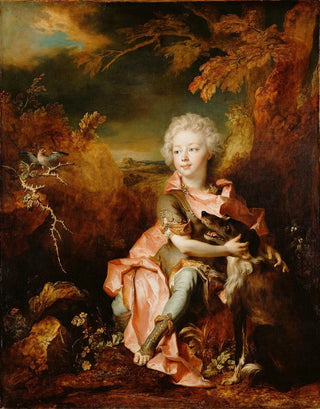Art print | Portrait of a boy in costume - Nicolas de Largillière


View from behind

Frame (optional)
In the fascinating world of 17th-century French painting, the artwork "Portrait of a Dressed-Up Boy" by Nicolas de Largillière stands out for its charm and elegance. This painting, which captures the innocence and curiosity of a young boy, offers a captivating glimpse into the art of portraiture at a time when individual representation was taking on unprecedented importance. Through this art print, viewers are invited to immerse themselves in a world where every detail, from the flamboyant costume to the delicate expressions, tells a story. Light plays a crucial role in this piece, illuminating the young model's face with a softness that evokes both tenderness and the vibrancy of childhood.
Style and uniqueness of the work
Largillière's style is characterized by an exceptional mastery of colors and textures. In "Portrait of a Dressed-Up Boy," he manages to create an atmosphere that is both intimate and lively, where each brushstroke seems to infuse new energy into the subject depicted. The choice of clothing, richly decorated and colorful, not only demonstrates the artist's talent but also his keen sense of observation. The way he renders light on the fabrics and accessories of the boy is remarkable, adding an almost tactile dimension to the canvas. The boy's expression, both mischievous and dreamy, captures attention and transports the viewer to a time when childhood was celebrated as a period of discovery and play.
The artist and his influence
Nicolas de Largillière, born in 1656, is one of the most renowned portraitists of his era. Trained in the art of painting during a period when portraiture proved to be a powerful means of asserting social status, Largillière adapted to the influences he encountered, from Flemish masters to the French court. His style, which combines tradition and innovation, left a lasting mark on portrait painting. By incorporating elements of everyday life and positioning his subjects in natural poses, he contributed to humanizing the art of portraiture, making it accessible and

Matte finish

View from behind

Frame (optional)
In the fascinating world of 17th-century French painting, the artwork "Portrait of a Dressed-Up Boy" by Nicolas de Largillière stands out for its charm and elegance. This painting, which captures the innocence and curiosity of a young boy, offers a captivating glimpse into the art of portraiture at a time when individual representation was taking on unprecedented importance. Through this art print, viewers are invited to immerse themselves in a world where every detail, from the flamboyant costume to the delicate expressions, tells a story. Light plays a crucial role in this piece, illuminating the young model's face with a softness that evokes both tenderness and the vibrancy of childhood.
Style and uniqueness of the work
Largillière's style is characterized by an exceptional mastery of colors and textures. In "Portrait of a Dressed-Up Boy," he manages to create an atmosphere that is both intimate and lively, where each brushstroke seems to infuse new energy into the subject depicted. The choice of clothing, richly decorated and colorful, not only demonstrates the artist's talent but also his keen sense of observation. The way he renders light on the fabrics and accessories of the boy is remarkable, adding an almost tactile dimension to the canvas. The boy's expression, both mischievous and dreamy, captures attention and transports the viewer to a time when childhood was celebrated as a period of discovery and play.
The artist and his influence
Nicolas de Largillière, born in 1656, is one of the most renowned portraitists of his era. Trained in the art of painting during a period when portraiture proved to be a powerful means of asserting social status, Largillière adapted to the influences he encountered, from Flemish masters to the French court. His style, which combines tradition and innovation, left a lasting mark on portrait painting. By incorporating elements of everyday life and positioning his subjects in natural poses, he contributed to humanizing the art of portraiture, making it accessible and






